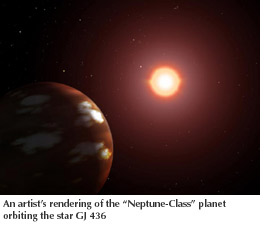| |
|||||
|
SFSU 'planet hunters' do it again | ||||
|
August 31, 2004 |
|||||
 Members
of the team that distinguished San Francisco State University in 1996
by being the first to detect planets outside of our solar system have
done themselves even better. The planet hunters have just detected some
even smaller extra-solar planets. Comparable in mass to Neptune, these
are the smallest extra-solar planets ever detected. The discovery of
the two "Neptune-Class" planets promises to intensify the search
for even smaller extra-solar planets. Members
of the team that distinguished San Francisco State University in 1996
by being the first to detect planets outside of our solar system have
done themselves even better. The planet hunters have just detected some
even smaller extra-solar planets. Comparable in mass to Neptune, these
are the smallest extra-solar planets ever detected. The discovery of
the two "Neptune-Class" planets promises to intensify the search
for even smaller extra-solar planets.
The team, funded jointly by the National Science Foundation (NSF)
and the National Aeronautics and Space Administration (NASA), are all
San Francisco State University family. Geoffrey Marcy is an adjunct
professor of physics at SFSU and professor of astronomy at University
of California at Berkeley; Debra Fischer is an SFSU assistant professor
of astronomy; and Paul Butler is an SFSU alum (BA, BS, MS) and staff
scientist at the Carnegie Institute in Washington, D.C. "Although lower-mass planets tend to be harder to detect than their higher-mass cousins, the statistics to date suggest that they occur more frequently," says Marcy. "And if that is the case, it suggests that we may soon be seeing more Neptunes ... and that Earth-sized planets, if we can ever detect them, may be downright abundant." While Neptune is 17 times the mass of Earth, "it's tiny in comparison to the 120-plus extra-solar planets that have been discovered so far," Marcy adds. "Virtually all of these objects are considerably heftier than our own solar system's heavy weights."
In July 2003, the team discovered a periodic wobble in a low mass star 33 light years away from Earth. Another 12 months of careful observation confirmed their suspicion. The mass, now known as "Gliese 436," has a Neptune-sized planet of at least 21 times the size of Earth. This planet speeds through a circular orbit once every 2.64 days. For more on the 'Neptune-Class" planets, see exoplanets.org.
|
|||||
 |
1600 Holloway Avenue, San Francisco, CA 94132 (415) 338-1111 |